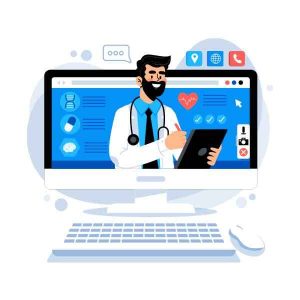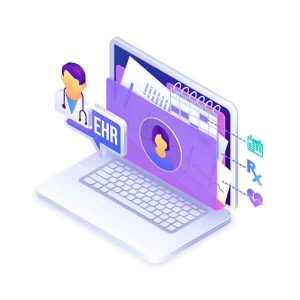Table of Contents
ToggleOverview
As health information technology has evolved, electronic health records (EHRs) have been dubbed “meaningful use” to improve healthcare quality and reduce disparities among populations. Besides the brighter side, which is functionality, there are some darker aspects, like medical errors, that professionally trained software handlers can cover.
In this blog post, we will delve into the world of EHR systems, exploring their benefits, features, and how they revolutionize healthcare. Whether you are a physician looking to implement an EHR system in your practice or someone new to the concept, this guide will provide you with all the information you need to know.
What is the Electronic Health Record (EHR) System?
Electronic Health Record (EHR) System is a patient-centered and comprehensive digital record book that is 24/7 ready to serve by providing instant information from its record library. The information purely exists on patient care and their records documentation. The preferable feature of multi-specialty EHR is the highest accuracy rate of data collection and the systematic record-keeping ability that has no fear of being lost until the practitioner’s will.
EHR, as mentioned before, is a multispecialty EHR that can play the following functions
- Patient’s medical history
- Allowing healthcare providers to access the same information in real-time
- Making diagnoses and treatments more efficient.
- Ensuring that the EHR is compliant with all relevant regulations
The Evolution of EHR Systems
Over the years, healthcare has significantly shifted from paper-based record-keeping to electronic systems. Traditional paper-based records were often time-consuming to maintain and had limitations regarding accessibility and security. With the advent of technology, EHR systems emerged as a game-changer in the healthcare industry.
EHR systems are digital repositories that store and manage patients’ health information in a structured manner. They provide various functionalities, including patient demographics, medical history, diagnostic reports, treatment plans, and more. Let’s dive deeper into the key features and benefits of EHR systems.
As mentioned before, EHR is not only monofunctional but a multispecialty EHR system that can be all in one solution for a provider’s practice management. Let’s highlight the most common practice management segments where EHR plays a crucial role.
EMR Vs. EHR
Any hospital or health system’s enterprise electronic health record (EHR) is its most powerful and effective platform, followed by its enterprise resource planning (ERP). EHRs handle clinical services, billing, and patient access, while ERPs handle backend operations, including financial management, human capital management, and supply chain management. Both of these massive and highly complex systems support almost every major business function or clinical activity in a hospital or health system on a daily basis and often complement one another.
For example, the EHR tracks the demand and utilization of instruments and supplies in the operating room, while the ERP is responsible for finding, acquiring, and replenishing those supplies.
You are in an operation theater, you need to keep a record of instruments needs and supplies. During a surgical procedure, the EHR tracks the demand and utilization of the tools and supplies required. However, the ERP is responsible for sourcing, acquiring, and replenishing these items.
Key Features of EHR Systems

- Centralized Patient Records: One of the primary features of EHR systems is their ability to store patient information in a centralized location. The time has gone when flipping through countless pages of paper records. With EHR systems, physicians can access patient data with just a few clicks. This results in improved efficiency and streamlined workflows, allowing healthcare providers to deliver more effective care.
- Interoperability and Data Sharing: EHR systems enable seamless data sharing and interoperability among various healthcare providers. It means that different hospitals, clinics, and laboratories can securely exchange patient information, resulting in better collaboration and continuity of care. Physicians can access a patient’s complete medical history, including past treatments, allergies, and test results, enabling them to make well-informed decisions.
- Decision Support Tools: EHR systems often come equipped with decision support tools that aid physicians in making accurate diagnoses and treatment plans. These tools can provide reminders for preventive screenings, suggest evidence-based treatment options, and alert physicians to potential drug interactions. By leveraging these tools, healthcare providers can enhance patient safety, reduce medical errors, and optimize clinical outcomes.
- Prescription Management and Electronic Prescribing: EHR systems have simplified the prescription management process. Physicians can electronically generate and send prescriptions directly to pharmacies, eliminating the need for handwritten prescriptions. It saves time and reduces the likelihood of errors due to illegible handwriting. Additionally, EHR systems can provide real-time information on drug interactions, allergies, and dosage recommendations, ensuring safer prescribing practices.
- Billing and Coding Integration: Integrating billing and coding functionalities within EHR systems streamlines the administrative tasks associated with healthcare. Physicians can generate accurate and timely billing codes, reducing the chances of claim denials and enhancing revenue cycles. With EHR systems, healthcare providers can easily track and manage patient encounters, automate charge capture, and streamline billing.
Steps to Successful EHR Implementation
The four steps to successful EHR implementation are:

- Develop a Comprehensive Plan: A well-executed plan of action can lead to optimal results. A successful implementation EHR plan should include a timeline, budget, and goals that will help guide the implementation process.
- Prepare the Staff: It includes providing training on the system to ensure everyone understands how it works and is prepared to use it. Training staff to use the EHR is the first and most crucial step.
- Test the System: At this testing step, it is important to ensure that the system is working properly and that the data collection process is accurately done. The testing system helps ensure that EHR complies with all relevant regulations and that EHR meets practice needs.
- Implement the System: Implementation is always a difficult task and needs to be handled in the most precise manner. This involves deploying the system and ensuring that it is integrated with other systems in the organization.
Benefits of EHR Systems
Improved Efficiency and Productivity
By adopting EHR systems, healthcare providers can significantly improve their efficiency and productivity. Automated Accessing patient information saves time, reduces documentation errors, and allows physicians to focus more on patient care. Additionally, features like electronic prescribing and decision support tools further enhance efficiency and prevent potential medical errors.
Enhanced Patient Safety and Quality of Care
EHR systems contribute to improved patient safety and quality of care. With accurate and up-to-date patient information readily available, healthcare providers can make informed decisions, leading to better treatment outcomes. Integrating decision support tools also helps detect potential medication errors or adverse reactions, ensuring patient safety.
Cost Savings and Revenue Optimization
Implementing EHR systems can lead to significant cost savings for healthcare organizations. By reducing paperwork, minimizing data duplication, and streamlining administrative tasks, healthcare providers can optimize their resources. Additionally, EHR systems help in accurate billing and coding, reducing claim denials, and optimizing revenue cycles.
Accessibility and Portability of Records
EHR systems make patient information accessible anytime and anywhere. Healthcare providers can securely access patient records remotely, allowing them to provide care even when not physically present. Moreover, the portability of EHR systems ensures seamless care transitions between different healthcare settings, ultimately improving patient outcomes.
Data-driven Insights and Population Health Management
EHR systems provide valuable insights into patient data that can be analyzed to identify the gaps. These data-driven insights enable healthcare providers to make informed decisions regarding population health management, disease prevention, and public health initiatives. EHR systems support population health management by facilitating data collection, analysis, and reporting.
Conclusion
In conclusion, EHR systems have transformed the way healthcare providers manage patient information. With their numerous features and benefits, Multispecialty EHR has become an integral part of modern healthcare practices. The benefits of improved efficiency, enhanced patient safety, cost savings, and data-driven insights make EHR systems a must-have for physicians and healthcare organizations.
If you are a physician looking to implement an EHR system, do thorough research and choose a solution that aligns with your practice’s specific needs. Take into consideration factors such as ease of use, training and support options, data security measures, and interoperability with other systems. By embracing EHR systems, healthcare providers can pave the way for a more connected and efficient healthcare ecosystem, ultimately improving patient outcomes and experiences.
Frequently Asked Questions Answered By Transcure Team
How Does EHR Software Work?
Electronic Health Record (EHR) software is used for storing and managing patient information in a secure digital environment. It allows medical staff to access patient information quickly and conveniently, eliminating paper records and streamlining the entire healthcare process. The software also allows for data sharing between healthcare providers, making it easier to coordinate care.
What Type of Data is an EHR?
Multi-specialty EHR is a digital version of a patient’s medical history that is stored in a secure database. EHRs contain a variety of data, including medical history, diagnosis, treatments, medications, lab results, and vital signs.
What are Multi Specialty EHR Components?
Electronic Health Records (EHRs) typically include components such as: Patient demographics, Family history, medical history, laboratory results, immunization records, radiology reports, vital signs, medications, allergies, and past and present treatments. EHRs also enable healthcare providers to share data securely and serve as a source of data for research and analytics.
What is the Most Critical Component of an EHR?
Security is the most important component of electronic health records (EHRs). All patient data must remain secure and confidential, and only authorized users should be able to access the data. EHRs must also be designed with robust security protocols to ensure data is accessed, stored, and shared securely.
What are the Advantages and Disadvantages of Electronic Medical Records?
The following are some advantages and disadvantages of the EHR system:
Advantages of Multi-Specialty EHR:- Improved accuracy in data
- Easier record keeping
- The ability to access and share information between healthcare providers
- The need for significant upfront investments
- The possibility of data entry errors if there is a lack of expert handler
Who Manages EHR Data?
It is typically managed by the healthcare organization that collects and stores the data. They are responsible for ensuring that the data is secure, accurate, and up to date.
Is an EHR an ERP System?
No, an EHR is not an ERP system. ERP is for Enterprise Resource Planning and is a system that allows organizations to manage their core business processes. It typically includes modules for managing finances, supply chain, customer relations, and human resources. An EHR, on the other hand, is an electronic health record system that stores patient medical information.
Is EHR a Relational Database?
No, an EHR is not a relational database. EHRs are typically structured as document-oriented databases that store medical records, images, and other information related to patient care. They are designed to be easily searchable and accessible to authorized healthcare providers.











